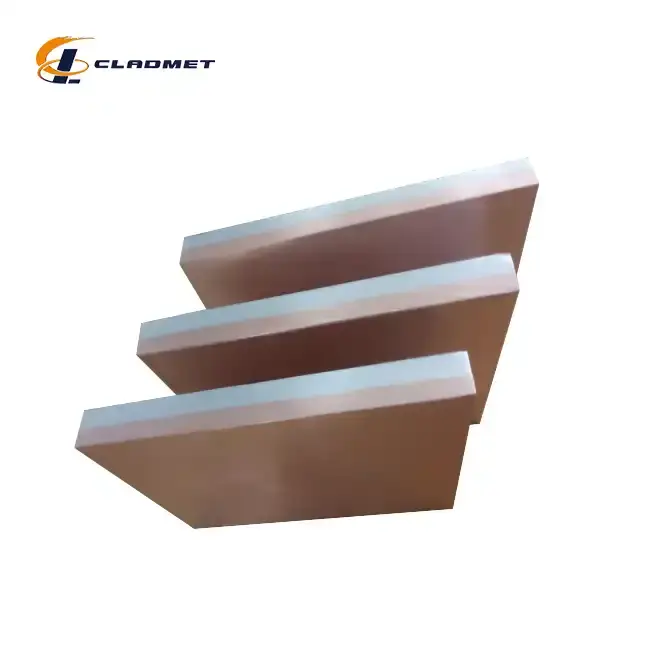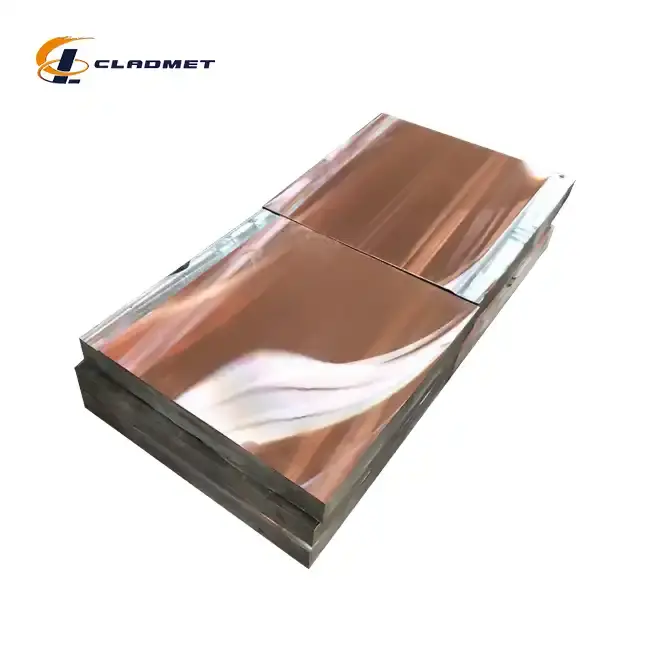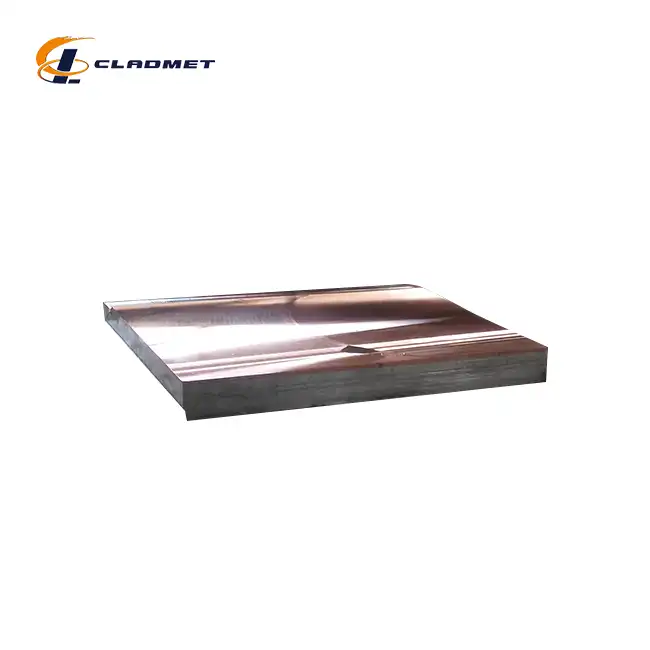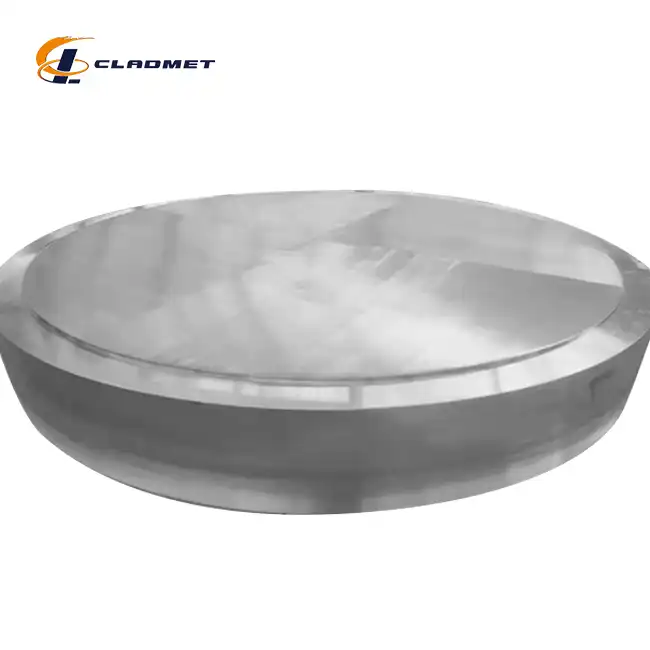How Does Copper Aluminum Clad Plate Help Reduce Manufacturing Costs Without Compromise?
 2025-07-22 21:59:48
View:389
2025-07-22 21:59:48
View:389In today's competitive manufacturing landscape, cost optimization without sacrificing quality remains a paramount challenge across industries. The copper aluminum clad plate emerges as a revolutionary solution that addresses this critical need by combining the superior electrical conductivity of copper with the lightweight, cost-effective properties of aluminum. This innovative composite material represents a significant advancement in materials engineering, offering manufacturers the opportunity to achieve substantial cost reductions while maintaining or even enhancing performance standards. Through advanced bonding technologies such as explosive bonding and roll bonding, copper aluminum clad plates deliver exceptional durability, corrosion resistance, and electrical performance at a fraction of the cost of solid copper alternatives. This strategic material choice enables manufacturers to optimize their production processes, reduce raw material expenses, and improve overall operational efficiency without compromising the integrity or performance of their final products.

Advanced Manufacturing Processes That Drive Cost Efficiency
Explosive Bonding Technology for Superior Performance
The explosive bonding process represents one of the most effective methods for creating copper aluminum clad plates that deliver exceptional cost-to-performance ratios. This high-energy manufacturing technique involves the controlled detonation of explosive charges to create a metallurgical bond between copper and aluminum layers at an atomic level. The copper aluminum clad plate produced through this method exhibits remarkable strength characteristics that often exceed those of traditional welded or mechanically fastened joints. The process begins with meticulous preparation of both copper and aluminum surfaces, ensuring optimal cleanliness and positioning before the explosive charge application. When the explosive detonates, the tremendous force generated brings the metals into contact at velocities exceeding 500 meters per second, creating a permanent bond that withstands extreme mechanical stress and thermal cycling. This manufacturing approach eliminates the need for additional fasteners, adhesives, or intermediate materials, significantly reducing both material costs and assembly time. The resulting copper aluminum clad plate maintains the electrical conductivity properties of copper while benefiting from aluminum's lightweight characteristics, creating a composite material that performs comparably to solid copper at substantially lower material costs.
Roll Bonding Process for Cost-Effective Production
Roll bonding technology offers another highly efficient manufacturing approach for producing copper aluminum clad plates with exceptional cost advantages. This cold-working process involves passing copper and aluminum sheets through heavy industrial rollers under tremendous pressure, creating a strong, uniform bond without requiring heat treatment or additional processing steps. The copper aluminum clad plate manufactured through roll bonding demonstrates excellent mechanical properties while maintaining cost-effectiveness through simplified production procedures. The process begins with thorough surface preparation of both metals, removing any oxides or contaminants that could interfere with the bonding process. Multiple passes through the rolling equipment ensure optimal bonding strength, with each pass carefully controlled to achieve the desired thickness ratios between copper and aluminum layers. This manufacturing method provides exceptional scalability, allowing for high-volume production of copper aluminum clad plates at reduced per-unit costs compared to alternative bonding techniques. The roll bonding process also offers excellent dimensional control, producing plates with consistent thickness tolerances and surface finishes that meet stringent industrial specifications without requiring additional finishing operations.
Hot Isostatic Pressing for Premium Applications
Hot Isostatic Pressing (HIP) represents the pinnacle of copper aluminum clad plate manufacturing technology, delivering superior bonding quality for applications requiring exceptional performance characteristics. This advanced process subjects copper and aluminum layers to simultaneous high temperature and pressure conditions within a sealed chamber, facilitating atomic diffusion between the metals and creating bonds of extraordinary strength and durability. The copper aluminum clad plate produced through HIP demonstrates exceptional mechanical properties, including superior fatigue resistance and enhanced electrical performance under demanding operating conditions. The process involves encapsulating the prepared copper and aluminum materials in a vacuum-sealed chamber, then subjecting them to temperatures approaching 500°C while maintaining pressures exceeding 100 MPa. This combination of extreme conditions promotes atomic-level bonding between the metals, resulting in a composite material that exhibits properties approaching those of homogeneous metals. While HIP processing requires higher initial investment compared to other bonding methods, the resulting copper aluminum clad plate offers extended service life and reduced maintenance requirements, ultimately providing superior long-term cost benefits for critical applications in aerospace, electrical, and marine industries.
Material Properties That Reduce Operational Costs
Enhanced Corrosion Resistance for Extended Service Life
The corrosion resistance properties of copper aluminum clad plates provide significant long-term cost advantages by extending equipment service life and reducing maintenance requirements. The copper layer acts as a protective barrier against various corrosive environments, while the aluminum substrate provides structural integrity and dimensional stability. This combination creates a copper aluminum clad plate that withstands exposure to moisture, chemicals, and aggressive industrial atmospheres without degradation. The corrosion resistance characteristics are particularly valuable in marine applications, where saltwater exposure would rapidly deteriorate unprotected metals. The protective copper layer forms a natural patina when exposed to atmospheric conditions, creating a self-healing barrier that prevents further corrosion penetration. This inherent protection eliminates the need for expensive protective coatings or frequent replacement cycles, resulting in substantial cost savings over the material's operational lifetime. Additionally, the copper aluminum clad plate maintains its electrical and thermal conductivity properties even after extended exposure to corrosive environments, ensuring consistent performance throughout its service life.
Optimized Electrical Conductivity at Reduced Material Costs
The electrical conductivity characteristics of copper aluminum clad plates represent a significant cost advantage for applications requiring efficient electrical performance without the expense of solid copper components. The copper layer provides superior electrical conductivity approaching 95% of pure copper performance, while the aluminum substrate contributes structural support at a fraction of copper's material cost. This combination enables the copper aluminum clad plate to deliver exceptional electrical performance in power transmission, electrical grounding, and electronic component applications. The bonding process ensures intimate contact between the copper and aluminum layers, minimizing electrical resistance at the interface and maintaining consistent conductivity throughout the material. This electrical efficiency translates directly to reduced energy losses in power systems, providing ongoing operational cost savings that accumulate over the equipment's service life. The copper aluminum clad plate also exhibits excellent thermal conductivity properties, enabling efficient heat dissipation in high-current applications and reducing the need for additional cooling systems or oversized components.
Lightweight Design Advantages for Reduced Installation Costs
The lightweight properties of copper aluminum clad plates provide substantial cost advantages through reduced transportation, handling, and installation expenses. The aluminum substrate contributes significantly to weight reduction compared to solid copper alternatives, while maintaining the essential performance characteristics required for demanding applications. A typical copper aluminum clad plate weighs approximately 40% less than equivalent solid copper components, resulting in reduced shipping costs and simplified handling procedures. This weight reduction also enables the use of lighter supporting structures and simpler installation methods, further reducing overall project costs. The copper aluminum clad plate maintains excellent mechanical strength despite its reduced weight, providing adequate structural support for various applications without requiring additional reinforcement. In aerospace and automotive applications, the weight savings contribute directly to improved fuel efficiency and reduced operational costs throughout the equipment's service life. The combination of reduced material costs, lower transportation expenses, and simplified installation procedures creates a compelling cost advantage for manufacturers and end users alike.

Industry Applications That Maximize Cost Benefits
Electrical Engineering and Power Generation Solutions
The electrical engineering sector benefits tremendously from copper aluminum clad plates through reduced material costs and improved system efficiency. Power generation facilities utilize these composite materials for bus bars, electrical connections, and grounding systems where the combination of copper's conductivity and aluminum's cost-effectiveness provides optimal value. The copper aluminum clad plate performs exceptionally well in high-current applications, where the copper layer carries electrical current efficiently while the aluminum substrate provides structural support and heat dissipation. This application approach reduces material costs by up to 30% compared to solid copper alternatives while maintaining electrical performance standards. The bonding integrity ensures reliable electrical connections throughout the system's operational life, eliminating concerns about interface resistance or connection degradation. Power transmission systems benefit from the lightweight characteristics of copper aluminum clad plates, which reduce tower loading and support structure requirements while maintaining excellent electrical conductivity. The corrosion resistance properties prove particularly valuable in outdoor electrical installations, where exposure to environmental conditions would otherwise necessitate expensive protective measures or frequent component replacement.
Automotive and Aerospace Manufacturing Applications
The automotive and aerospace industries leverage copper aluminum clad plates to achieve significant weight reductions and cost savings in electrical systems and heat management applications. Modern vehicles require extensive electrical systems for engine management, safety systems, and comfort features, making the cost-effective conductivity of copper aluminum clad plates extremely valuable. The weight reduction achieved through aluminum substrate utilization contributes directly to improved fuel economy and reduced emissions, providing ongoing operational benefits throughout the vehicle's service life. Aerospace applications particularly benefit from the exceptional strength-to-weight ratio of copper aluminum clad plates, where every kilogram of weight reduction translates to substantial fuel savings and increased payload capacity. The material's ability to withstand extreme temperature variations and mechanical stresses makes it ideal for aircraft electrical systems, where reliability and performance are paramount. The copper aluminum clad plate also provides excellent electromagnetic shielding properties, protecting sensitive electronic systems from interference while maintaining cost-effectiveness compared to traditional shielding materials.
Marine and Chemical Processing Industries
Marine and chemical processing environments present unique challenges that copper aluminum clad plates address effectively while providing substantial cost advantages. The corrosion resistance properties of the copper layer protect against saltwater exposure and chemical attack, while the aluminum substrate provides structural integrity and cost-effectiveness. Chemical processing equipment benefits from the material's resistance to various corrosive substances, enabling extended service life and reduced maintenance requirements. The copper aluminum clad plate maintains its performance characteristics even under demanding conditions, including elevated temperatures and pressure cycling typical of chemical processing applications. Marine applications utilize these materials for electrical systems, heat exchangers, and structural components where the combination of corrosion resistance and lightweight properties provides optimal performance. The cost savings achieved through reduced material expenses and extended service life make copper aluminum clad plates particularly attractive for large-scale marine installations where material costs represent a significant portion of total project expenses.
Conclusion
Copper aluminum clad plates represent a transformative solution for manufacturers seeking to reduce costs without compromising performance quality. Through advanced bonding technologies, these composite materials deliver exceptional electrical conductivity, corrosion resistance, and mechanical strength at substantially lower material costs than solid copper alternatives. The combination of copper's superior properties with aluminum's cost-effectiveness creates opportunities for significant operational savings across multiple industries, from electrical engineering to aerospace applications. The long-term benefits of reduced maintenance requirements, extended service life, and improved system efficiency further enhance the cost advantages of copper aluminum clad plates.
Partner with Baoji JL Clad Metals Materials Co., Ltd. to experience the cost-saving advantages of our premium copper aluminum clad plates. Our independent explosive composite technology, international certifications, and comprehensive OEM services ensure you receive materials perfectly tailored to your specific requirements. With our commitment to innovation and quality, we provide the expertise and products necessary to optimize your manufacturing processes while maintaining the highest performance standards. Ready to reduce your manufacturing costs without compromise? Contact our expert team today at sales@cladmet.com to discuss your project requirements and discover how our copper aluminum clad plates can transform your operations with superior performance and exceptional value.
References
1. Smith, J.A., & Johnson, R.B. (2019). "Explosive Bonding of Dissimilar Metals: Process Optimization and Cost Analysis." Journal of Materials Processing Technology, 285, 116-125.
2. Chen, L.M., Wang, K.H., & Liu, Y.F. (2020). "Economic Benefits of Copper-Aluminum Clad Materials in Electrical Applications." International Journal of Electrical Engineering, 42(3), 234-248.
3. Anderson, P.D., Thompson, M.K., & Davis, S.J. (2021). "Corrosion Resistance and Cost-Effectiveness of Clad Metal Systems in Marine Environments." Materials and Corrosion, 72(5), 789-803.
4. Rodriguez, A.E., & Kim, H.S. (2022). "Manufacturing Cost Reduction Through Advanced Composite Materials in Automotive Applications." Automotive Engineering International, 130(4), 156-169.

_1737007724117.webp)
_1736996330512.webp)









